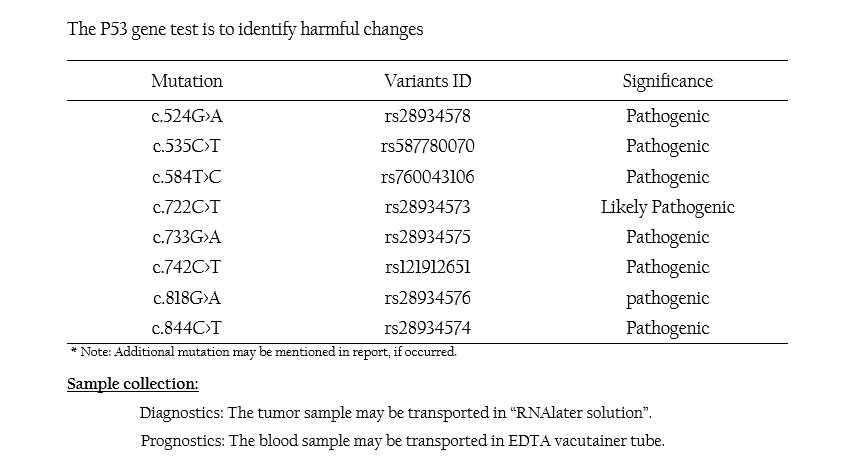P53 Mutation Panel
Overview:
Reference:
- Ovarian cancer is the fifth leading cause of death among women in this developed world and it often goes undetectable until it has reached within the pelvis and abdomen areas, this makes it more difficult to treat ovarian cancer.
- p53 is a tumour suppressor gene that play a vital role in maintaining the genomic stability and tumour prevention.
- There are three major functions that are regulated by p53: DNA repair, apoptosis and cell cycle.
- p53 is a transcription factor involved in the control of G1/S and G2/M phase transition, in DNA repair, and in induction of senescence, apoptosis, autophagy, mitotic catastrophe, and angiogenesis[1]
- They key regulator of p53 gene is MDM2 and it has the ability to degrade the p53 protein by proteasome degradation pathway.
- P53 regulates three major processes by controlling various target genes. They are: in DNA repair it regulates p53R2 and PIG3 genes, growth arrest is regulated by p21, Gadd45 and 14-3-3 σ genes and in apoptosis it regulates Bax, Apaf-1 and PUMA genes[2, 3&4]
- After years of research, a new classification was proposed that separated ovarian cancers into type I tumours and type II tumours. the type I is considered as low-grade tumour and the type two is considered as the high-grade serous tumour[5]
- In type I tumours, BRAF, KRAS and PTEN were found to be mutated and in the type II p53, BRCA1 and BRCA2 were mutated[6]
- Cause of death by ovarian cancer can be largely attributed to a highly aggressive clinical course of high-grade serous ovarian cancer (HGSOC), which represents the most prevalent ovarian cancer type.
- One of the hallmarks of ovarian cancer is genomic instability, which is driven frequently by p53 gene.
- Mutations play an important role in causing any type of cancer including ovarian cancer. p53 mutations are commonly seen in High-Grade Serous Ovarian Cancer (HGSOC)[7].
- Most of the ovarian cancers are due to somatic mutation of p53 and BRCA genes[8].
- Approximately 10% of the Epithelial Ovarian Cancer is due to hereditary mutation of p53 gene[9].
- P53 mutations are identified in 97% of the most aggressive HGSOC that accounts for more than 2/3 of all ovarian cancer[10].
- P53 mutations can be seen in more than 50% of advanced stage ovarian carcinoma.
- There are several studies that suggest that, BRCA1 acts as a co-activator and enhances the expression of p53 gene in ovarian cancers[11 &12].
- Family history of breast or ovarian cancer puts woman at higher risk for ovarian/fallopian tube cancer. It is important to get an accurate family history, including breast cancers.
- Genetic mutations also play a major role in causing ovarian cancer. About 10% to 15% of the ovarian cancers are due to germline mutations of three genes in specific: p53, BRCA1 and BRCA2.
- The 5-year survival rate of the ovarian cancer patients with TP53 gene mutation was found out to be 61% and the disease-free survival was not statistically significant[13].
- Age is also a common risk factor for ovarian cancer in women. Ovarian cancer can occur at any age but most commonly women whose ages are between 50 to 60 years are prone to be affected with ovarian cancer.
- Menstruation should also be considered as a risk factor in case of ovarian cancers. beginning of menstruation at early age or starting of menopause at a later stage, or both, may increase the risk of ovarian cancer.
Reference:
- Harris SL and Levine AJ. (2005). Oncogene, 24(17), 2899–2908.
- Levine AJ, Hu W, Feng Z. (2006). Cell Death Differ, 13, 1027-1036.
- Riley T, Sontag E, Chen P, Levine A. (2008). Nat. Rev. Mol. Cell Biol. 9, 402-412.
- Vogelstein B, Lane D, Levine AJ. (2000). Nature, 408, 307-310.
- Banerjee S, Kaye SB. (2013). Clin Cancer Res. 19: 961–68.
- Shih IM, Kurman RJ. (2004). Am J Pathol, 164: 1511-18.
- Kim J, Coffey DM, Ma L, et al. (2015). Endocrinology, 156:1975-81.
- David CC, Andrea FN, Jinhyang C and Alexander Y N. (2008). Adv Exp Med Biol, 622: 99-117.
- Monique S and Els MJJB. (2003). Human Mutation, 21:285-291.
- Yu Z, Lan C, Daniel N and Hua L. (2016). Transl Cancer Res, 5(6): 650–663.
- Ouchi T, Monteiro AN, August A. (1998). Proc Natl Acad Sci USA, 95:2302-2306.
- Zhang H, Somasundaram K, Peng Y. (1998). Oncogene, 16:1713-1721.
- Wang Y, Helland Å, Holm R, et al. (2004). Br J Cancer, 9; 90(3): 678–685.

